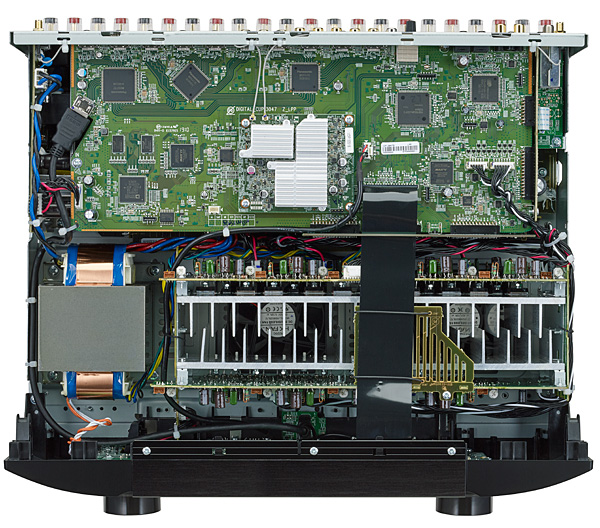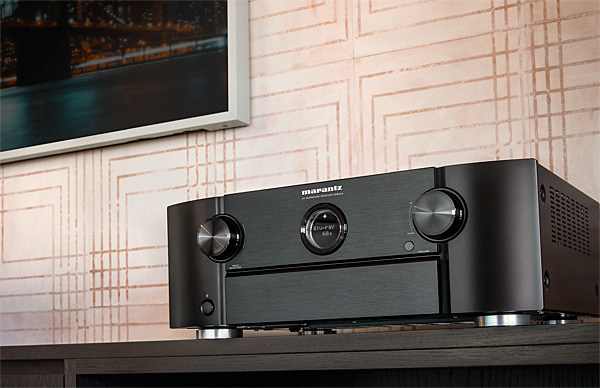Marantz SR6014 9.2-Channel A/V Receiver Review Page 2
 Here's how that works. The SR6014's back panel actually has 11 speaker connections, allowing you to hook up a 7.2.4 configuration with both rear surrounds and four overhead speakers. The receiver will then select automatically—or you can choose manually—which speakers you want to use based on the content being played. In other words, it can drive a 7.2-channel configuration for regular surround-encoded programs, and then switch to 5.2.4 for Dolby Atmos or DTS:X content. That's an excellent compromise, and it should also be noted that the SR6014's 11.2-channel processing allows for a full 7.2.4 speaker setup when you add an external two-channel amp. One nice touch is that you can individually adjust the level of the two subwoofer outputs, even if they are both conveying the same signal.
Here's how that works. The SR6014's back panel actually has 11 speaker connections, allowing you to hook up a 7.2.4 configuration with both rear surrounds and four overhead speakers. The receiver will then select automatically—or you can choose manually—which speakers you want to use based on the content being played. In other words, it can drive a 7.2-channel configuration for regular surround-encoded programs, and then switch to 5.2.4 for Dolby Atmos or DTS:X content. That's an excellent compromise, and it should also be noted that the SR6014's 11.2-channel processing allows for a full 7.2.4 speaker setup when you add an external two-channel amp. One nice touch is that you can individually adjust the level of the two subwoofer outputs, even if they are both conveying the same signal.
Setup
To help get the most from your system, the SR6014 includes Audyssey MultEQ XT32, a maxed-out version of Audyssey's speaker calibration software. This measures each speaker from eight different positions around the main listening area using a calibration microphone (included), and with 11 speakers plus a subwoofer in my setup, the complete measuring process took over 30 minutes. Of course, one of my goals when evaluating any AVR is to assess how it sounds without tonal corrections, so I normally run the software and then turn off most of the processing before sitting down for any critical listening. I find that the automated setup is good for getting individual speaker level and distance settings sorted out, but I usually go back and tweak the results for those by hand. Audyssey did detect that I had connected one of my speakers with the polarity reversed, which proves that it can also provide a useful double-check of system setup.
Performance
To give the SR6014 an all channels on deck workout, I streamed the final scene from episode two of Tom Clancy's Jack Ryan from Amazon Prime Video where the police get ambushed while raiding a Paris apartment. The Dolby Atmos mix here has automatic gunfire breaking out in every direction, with sound bouncing off the walls and ceiling of the small interior spaces in the apartment. As real as it sounded, I thankfully didn't feel the need to duck and dodge any bullets. The explosion at the end of the scene underscored the Marantz's ability to convey dynamic slam, even if much of the sound's weight was delivered by my separate powered subwoofer.

I next listened to an uncompressed stream of Andre Previn's famous 1973 EMI recording of Holst's The Planets—and actually got my upstairs neighbor to pound on the floor when things get really loud near the end of the Mars movement! Even at such loud levels, the Marantz's complete freedom from strain or congestion gave the brass and woodwinds a powerful sense of drive and impact. Moving on to the second movement, the sweeping strings had a delicate sense of bloom and body, with lots of space around the instruments. Also, the soundstage extended well beyond the physical locations of my PSB Synchrony One tower speakers.
Looking for something more contemporary, I cued up the title track from Janis Ian's Breaking Silence album on vinyl. Marantz takes care to point out that the SR6014's phono stage is no mere afterthought and features its HDAM (hyper dynamic amplifier module) discrete RIAA circuitry. Whatever is behind it, the Marantz's phono input lent rich tonal color to the drums and cowbell (yes, more cowbell!) in this impressive recording. Janis Ian harmonizes with her own voice on the title track, and the Marantz did a great job preserving the nuances of her delicate, half-whispered vocals.

X-Men Origins: Wolverine is a pretty lame movie, but a scene in chapter 4 from the Blu-ray involving a confrontation with a Nigerian diamond lord contains plenty of punchy dynamic action. The music is underpinned by ultra-deep, throbbing bass that is countered in the soundtrack by lots of piercing transients from the gunfire. The SR6014 made it easy to hear subtle differences in the sound effects, such as a bullet being deflected by a sword compared with a bullet hitting a wall or shell casings hitting the ground. This let me easily follow the action, as opposed to having to strain to discern sounds that would otherwise be confusingly blended together.
Conclusion
It can be hard to tell one A/V receiver apart from another these days since most brands provide very similar sets of features and rely on basic styling to convey any sense of differentiation. Marantz takes a somewhat different approach, putting its stamp on a design by incorporating features aimed squarely at providing superior sonics. For the SR6014, the result is a sweet -sounding receiver that delivers the goods with music but can also be relied on for kick-ass home theater performance.





























































